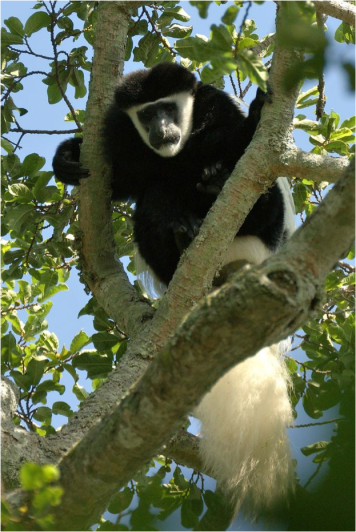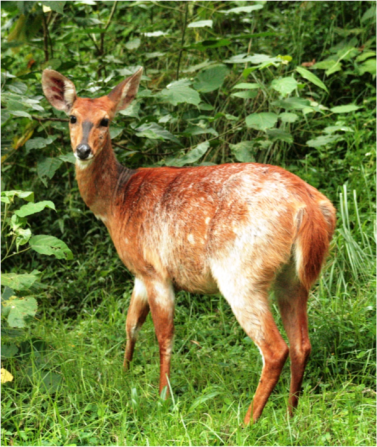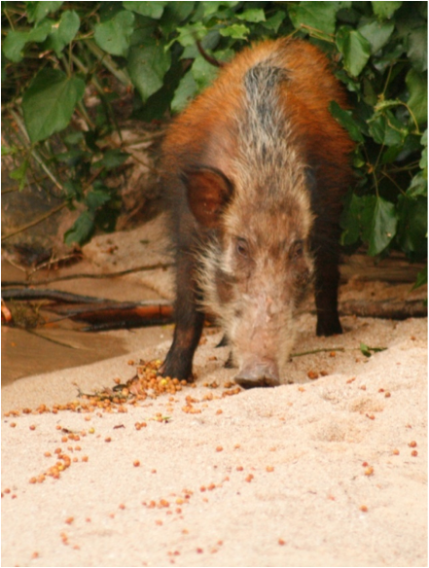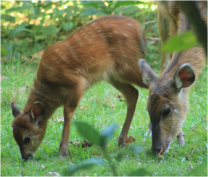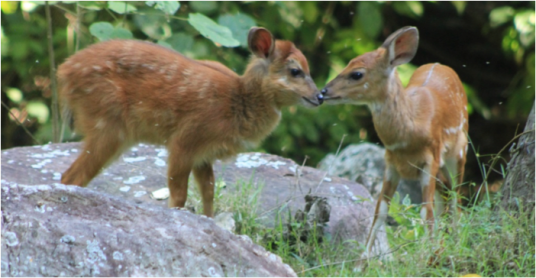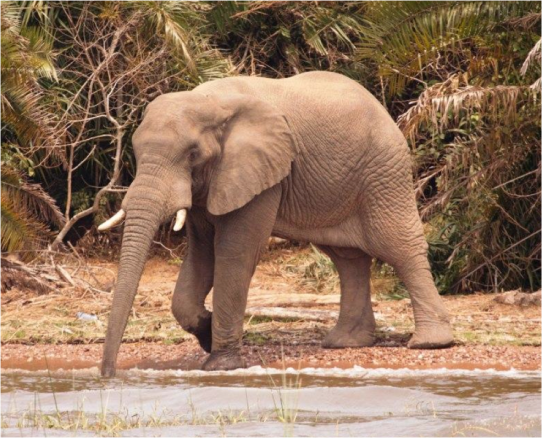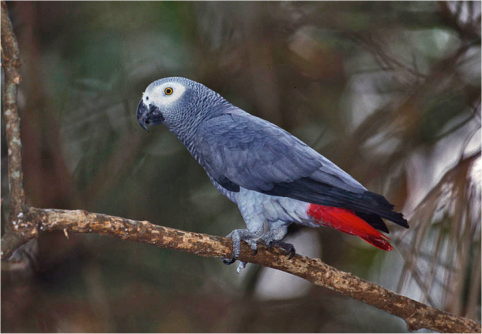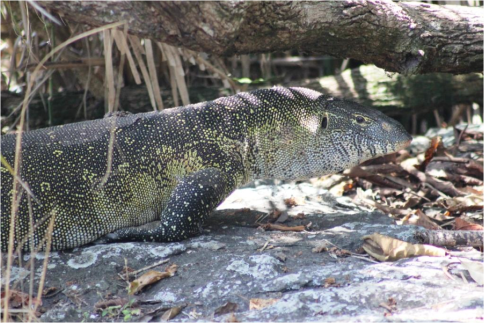Rubondo: Life Around Camp
By Janine Bronkhorst, Rubondo Island Camp Manager
Rubondo Island is a sanctuary to many different species of animals, but these particular ones love hanging around camp!
Meet the crew:
Rodger – The Black & White Colobus Monkey
Colobus guereza
Photo by Anton Crone
Colobus monkeys generally live in groups of around nine individuals, but Rodger was exiled from his group many years ago and has found refuge within the camp area. He can be heard barking loudly all through camp, but he is also very shy, so although we always hear when Rodger is around, it is sometimes very hard to spot him.
Colobus monkeys have a life span of around 20 years and are omnivorous. These monkeys were introduced to Rubondo in 1977 from Mount Meru. They were hunted to near extinction in some areas for their beautiful fur to make dance costumes, capes and hats. The biggest threat they face today is loss of habitat as deforestation is such a big factor all over Africa. Rubondo Island offers the perfect sanctuary for our furry friends.
Unlike other monkeys, colobus monkeys do not have thumbs. They are strictly leaf-eaters and spend most of their time in treetops, preferring to eat the tender, young leaves found there. However, their complex stomachs enable them to digest mature or toxic foliage that other monkeys cannot. They are also the most arboreal of all African monkey species.
Bella – The Bushbuck
Tragelaphus scriptus
Bella is easy to spot amongst others due to her greyish white side. She is one of the older ladies around and mother to many other bushbuck in the area and who all have her greyish white signature. Her newest baby is named Charlie and was born in January 2014; he has a grey patch on the right side of his neck.Bushbuck have a gestation period of about 6 months and keep their young hidden for the first 4 months after birth. Infants will reach maturity after one year and a male’s horns will only be full-grown after three years.Although many bushbuck can be found in one area, they are still strictly solitary animals.
Bertha – The beach loving Bush Pig
Photamochoeruslariats
Bertha is around all year long, but it is only in December and January when she comes around to the lounge area and acts like a vacuum cleaner to eat the yellow berries that decorate our deck. She loves hanging out on the beach too!A bushpig’s diet adapts to the seasons. They are omnivorous and will feed on everything from fungi, small reptiles, roots and bulbs to fruit whenever it becomes available.They become sexually mature at about 18 months and will give birth to up to 10 piglets after a gestation period of 2 months.It is unknown how the pigs came to Rubondo; speculation suggests that they drifted over on a papyrus float.
Bruce, Sidney and Jumpie – The Sitatungas
Traphelagus Spekei
Bruce is a big male that loves being photographed; he is often found around the main area and is completely unphased by the Homo sapiens population that often walks by.Sidney is a young female that feels that the pool is sometimes a safer option to drink from than the lake, as there seem to be less crocodiles around this watering hole! She gave birth to a very playful Jumpie in January 2014.Sitatungas are Africa’s only true amphibious antelopes. Often referred to as the ‘water-kudu’, they live mostly in swamplands on the fringes of forests. They are distinguished by their long, splayed hooves that make the sitatunga clumsy and vulnerable on firm terrain but well-adapted for walking through muddy, vegetated swamplands. They are good but slow swimmers capable of paddling for several miles. Males are also considerably larger than females and have long, twisted horns.Charlie and Jumpie also happen to be great friends!
Gerard – The grumpy Elephant
Loxodonta africana
Six Elephants were introduced to Rubondo in the 1970’s. It is said that the group that was brought here were all orphaned by ivory poachers, which explains their stroppy behaviour towards humans. There is now an estimated population of about 50.
Two main types of elephant are known through Africa; the bush or savannah elephant and the forest elephant. Elephants adapt easily to ecological conditions, therefore more than 25 subspecies are found throughout Africa. The Rubondo group is no different; the bush elephants that were brought here had to genetically change to adapt to their new forest environment. Forest elephants are known to be smaller in size than bush elephants, but have much larger and straighter tusks to enable them to move easier through dense forest. The Rubondo elephants are very different in both aspects; they have very small tusks and are much bigger than any other elephants we have seen! Due to the abundance of food and water on the island, they do not need long tusks to dig for roots or ward off predators. They are very destructive and use their big size to push over the tall trees in order to get to the green leaves on top. They also behave different to other elephant and are mostly active at night.
Peter – The African Grey Parrot
Psittacus erithacus
Early in the morning, the parrots can be heard throughout camp and although they seem to be everywhere, they are hard to spot! Peter and his friends love the big fig trees where they easily hide in the dense canopy while feasting on wild figs.Although these parrots are mainly herbivores, they will sometimes feed on small insects too. They are often kept as domestic pets for their ability to mimic sounds and this is also how they came to Rubondo.
The African Grey Parrots were introduced to Rubondo in 2000. They were part of an illegal shipment of approximately 200 parrots that were caught in the wild in Cameroon, and destined to be shipped to Europe to be sold as pets. They were confiscated in Nairobi and a spent two years at in animal shelter, during which time their future was debated endlessly. Finally the remaining 37 parrots made the trip to Rubondo. Now, one can see these beautiful creatures as they should be, flying around in flocks, or climbing around the tops of the trees in search of food, all the while adding a cacophony of screeching sounds to the already noisy forest symphony. They often make us giggle when they try to mimic the fish eagles.
Monty – The Monitor Lizard
Varanus niloticus
Monty is particularly big for his kind; they have grown up to 2.5m long in certain recorded cases, but are generally only about 120 to 150 cm long. He lives on the rocky shore just outside the main area and sometimes comes out in the open to bask in the sun so that we can admire him.
Monitor Lizards are superb swimmers and can stay submerged for up to 20 minutes at a time. These lizards have a varied diet, are fond of crabs and mussels but will eat any suitable vertebrates like frogs, small fish, birds and bird eggs. They are notorious raiders of unattended crocodile nests.
Females will often claw their way into an active termite mound and lay their eggs inside. The termites then seal the hole again and the eggs are kept warm and moist while safely inside. They take up to a year to incubate.
Some of the other species that were released on the island, like the suni and giraffe, are a bit shyer, and we only see glimpses of them from time to time. The nocturnal critters, like the genet and marsh mongoose that are indigenous to the island, sometimes appear at night to have a quick peek at our guests.
The island holds so much mystery, with so many hiding places where we often find new and exciting discoveries. It is truly sublime and we are extremely lucky to be able to call this magical island home!
If you would like to come stay at Rubondo Island Camp and meet all of their friendly critters please visit website or enquire here.
The post Rubondo: Life Around Camp appeared first on Asilia Africa.
More Wildlife & Conservation Articles

Leopard vs Cheetah : Can You Tell The Difference
01 April 2020How often do you mistake a leopard for a cheetah or vice versa? I’m sure we’v...

What’s the difference? National Parks, Game Reserves, and Conservancies in East Africa
02 February 2020To most of us, a national park, game reserve, or conservancy are all the same...

Electric Vehicles: The Future Of East African Safari Travel?
12 January 2020October 2019 saw the arrival of our first electric, solar-powered safari vehi...

Guest Gallery: The Serengeti At Its Best
27 November 2019We recently had the pleasure of welcoming guests, Chris and Monique Fallows t...
